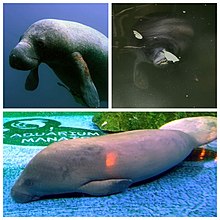
Back Lamantyn Afrikaans Manati ALS Sǣcū ANG خروف البحر Arabic خروف البحر ARZ Trichechus AST Pogdol (Trichechus) AVK Lamantinlər Azerbaijani Ламанціны Byelorussian Лямантыны BE-X-OLD
| Manatees | |
|---|---|

| |
| Clockwise from upper left: West Indian manatee, Amazonian manatee, African manatee | |
| Scientific classification | |
| Domain: | Eukaryota |
| Kingdom: | Animalia |
| Phylum: | Chordata |
| Class: | Mammalia |
| Order: | Sirenia |
| Family: | Trichechidae |
| Subfamily: | Trichechinae |
| Genus: | Trichechus Linnaeus, 1758 |
| Type species | |
| Trichechus manatus Linnaeus, 1758
| |
| Species | |
| |
| Synonyms | |
| |
Manatees (/ˈmænətiːz/, family Trichechidae, genus Trichechus) are large, fully aquatic, mostly herbivorous marine mammals sometimes known as sea cows. There are three accepted living species of Trichechidae, representing three of the four living species in the order Sirenia: the Amazonian manatee (Trichechus inunguis), the West Indian manatee (Trichechus manatus), and the West African manatee (Trichechus senegalensis). They measure up to 4.0 metres (13 ft 1 in) long, weigh as much as 590 kilograms (1,300 lb),[2] and have paddle-like tails.
Manatees are herbivores and eat over 60 different freshwater and saltwater plants. Manatees inhabit the shallow, marshy coastal areas and rivers of the Caribbean Sea, the Gulf of Mexico, the Amazon basin, and West Africa.
The main causes of death for manatees are human-related issues, such as habitat destruction and human objects. Their slow-moving, curious nature has led to violent collisions with propeller-driven boats and ships. Some manatees have been found with over 50 scars on them from propeller blades. Natural causes of death include adverse temperatures, predation by crocodiles on young, and disease.
- ^ "Trichechus Linnaeus 1758 (manatee)". Fossilworks.org. Archived from the original on 2023-06-05. Retrieved 2021-12-17.
- ^ West Indian Manatee Facts and Pictures – National Geographic Kids Archived 2011-06-26 at the Wayback Machine. Kids.nationalgeographic.com. Retrieved on 2011-12-03.